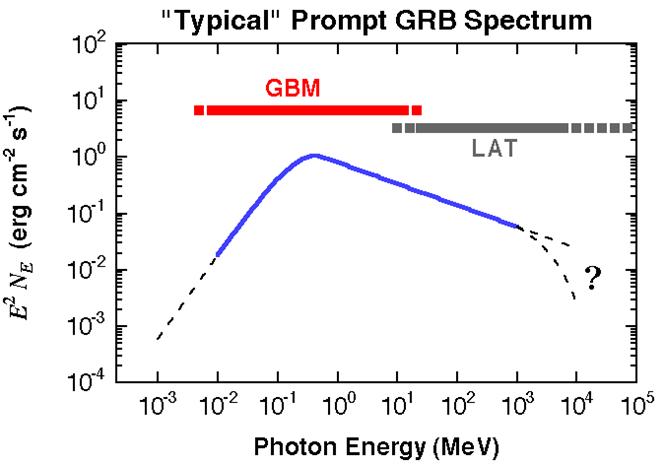Gamma-ray Burst Monitor (GBM)
The Fermi GBM provides simultaneous low-energy spectral and temporal measurements for all GRBs within the LAT FOV. The combined GBM and LAT effective energy range spans more than 7 energy decades from 10 keV to 300 GeV. The GBM extends the energy coverage from below the typical GRB spectral break at ~100 keV to above the LAT's low-energy cutoff for inter-instrument calibration. Furthermore, the GBM's sensitivity and FOV are commensurate with the LAT's to ensure that many bursts will have simultaneous low-energy and high-energy measurements with similar statistical significance. The GBM also assists the LAT in detecting and localizing GRBs rapidly by providing prompt notification to the ground of a burst trigger. Finally, the GBM provides coarse GRB locations over a wide FOV that can be used to repoint the LAT at particularly interesting bursts (both inside and outside the LAT FOV) for gamma-ray afterglow observations. These locations are also sent to the ground to notify external follow-up observers.

Using detection criteria similar to those of CGRO's Burst And Transient Source Experiment (BATSE), the predicted GBM burst detection rate is ~200 bursts per year.
In addition to measuring low-energy spectra below the LAT threshold, the GBM significantly improves the constraints on high-energy spectral behavior compared to those of the LAT alone. The combination of GBM and LAT data therefore provides a powerful tool to study GRB spectra and their underlying physics.
Detector Capability
| Characteristic | Capability |
|---|---|
| Low Energy Limit | <10 keV |
| High Energy Limit | >25 MeV |
| Energy Resolution (FWHM, 0.1-1 MeV) | <10% |
| Field of View (Co-aligned with LAT FOV) | >8 sr |
| Time Accuracy (Relative to spacecraft time) | <10 microseconds |
| Average Dead Time | <10 microsecond/count |
| Burst Sensitivity (Peak 50-300 keV flux for 5σ detection in ph cm-2 s-1) | <0.5 cm-2 s-1 |
| Burst Alert Locations (1σ systematic error radius) | <15° |
| Burst Alert Time Delay (Time from burst trigger to spacecraft notification (used to notify ground or LAT) | <2 s |
Hardware
To achieve the required GBM performance, the design and technology borrow heavily from previous GRB instruments, particularly from BATSE. Like BATSE, the GBM uses two types of cylindrical crystal scintillation detectors, whose light is read out by PMTs.

An array of 12 sodium iodide (NaI) detectors (0.5 in. thick, 5 in. diameter) covers the lower end of the energy range up to ~1 MeV. The GBM triggers off of the rates in the NaI detectors. Each NaI detector consists of the crystal, an aluminum housing, a thin beryllium entrance window on one face, and a 5 in. diameter PMT assembly (including a pre-amplifier) on the other. These detectors are distributed around the Fermi spacecraft with different orientations to provide the required sensitivity and FOV. The cosine-like angular response of the thin NaI detectors are used to localize burst sources by comparing rates from detectors with different viewing angles. To cover higher energies, the GBM also includes two 5 in. thick, 5 in. diameter bismuth germanate (BGO) detectors. The combination of the BGO detectors' high-density (7.1 g cm-3) and large effective Z (~63) results in good stopping power beyond the low end of the LAT energy range at ~20 MeV. The BGO detectors are placed on opposite sides of the Fermi spacecraft to provide high-energy spectral capability over approximately the same FOV as the NaI detectors. For redundancy, each BGO detector has two PMTs located at opposite ends of the crystal.


The signals from all 14 GBM detectors are collected by a central Data Processing Unit (DPU). This unit digitizes and time-tags the detectors' pulse height signals, packages the resulting data into several different types for transmission to the ground (via the Fermi observatory), and performs various data processing tasks such as autonomous burst triggering. In addition, the DPU is the sole means of controlling and monitoring the instrument. For example, the DPU controls the PMTs' power supply to maintain their gain.
Further technical information about the GBM can be found at the GBM Instrument Operations Center.
Data Types
There are three basic types of GBM science data: (1) continuous data consisting of the count rates from each detector with various (selectable) energy and time integration bins; (2) trigger data containing lists of individually time-tagged pulse heights from selected detectors for periods before and after each on-board trigger; and (3) Alert Telemetry sent down to the ground immediately after a burst containing computed data from a burst trigger, such as intensity, location, and classification. The Burst Alert, the first packet of the Alert Telemetry, arrives at the Gamma-ray burst Coordinates Network (GCN) within 15 seconds of the burst detection. Alerts originating in the GBM are also sent to the LAT to aid in LAT GRB detection and repointing decisions. The remaining data types are transmitted via the scheduled Ku-band contacts. The GBM produces an average of 1.4 Gbits/day, with a minimum of 1.2 Gbits/day and a maximum allocated rate of 2.2 Gbits/day.
Full details are given on the GBM Data Products Page.
The GBM Collaboration
The Fermi GBM collaboration includes scientists from the Marshall Space Flight Center (PI: Dr. C. A. Wilson-Hodge), the Max Planck Institute for Extraterrestrial Physics, the University of Alabama in Huntsville, the Universities Space Research Association (USRA), and Los Alamos National Laboratory. The Marshall, University of Alabama, and USRA scientists are housed at the National Space Science and Technology Center (NSSTC) in Huntsville.
